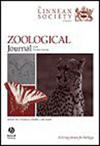The bird tear-drinking moths of the genus Hemiceratoides (Lepidoptera: Erebidae)
IF 3
2区 生物学
Q1 ZOOLOGY
引用次数: 0
Abstract
New footage confirms Hemiceratoides moths to be bird tear-drinking. Bionomics of Hemiceratoides is updated, and its taxonomy revised, with descriptions of Hemiceratoides ornithopotis sp. nov. and H. avimolestum sp. nov., while Cynisca thysbe, type species of Siccyna (= Cynisca), is recombined as H. thysbe comb. nov. (thus Hemiceratoides = Siccyna synon. nov.), whereas another Siccyna, originally Cynisca reichi, is found to be conspecific with Devena atomifera (synon. nov.). We highlight the striking proboscis modifications in Hemiceratoides compared to non-calpine erebids that may perhaps be incidental eye frequenters. Hemiceratoides sittaca has remarkable, sexually dimorphic labial palps, which are fang-like in males, probably assisting in tear feeding. Hemiceratoides also features unusual valval processes, an asymmetric whip- or stick-like juxta, and sclerotizations surrounding the ostium bursae. A phylogenetic tree reconstructed with eight nuclear genes as well as COI for the subfamilies Hypocalinae + Calpinae confirms the prior finding that Hemiceratoides belongs to tribe Ophiderini, not to Calpini, and supports previously held relationships between calpine genera, except that (Miniodes + Phyllodes) do not form a sister group relationship with (Hemiceratoides + Eudocima). We thus discuss the controversy over the evolution of the unusual feeding habits in Hemiceratoides. Finally, Calyptra canadensis comb. rev. is updated due to a newly established synonymy Calyptra = Percalpe synon. nov.鸟类饮泪蛾属 Hemiceratoides(鳞翅目:Erebidae)
新镜头证实 Hemiceratoides蛾是鸟类的泪腺。更新了 Hemiceratoides 的生物组学,并修订了其分类法,描述了 Hemiceratoides ornithopotis sp、新种),而另一种 Siccyna(原为 Cynisca reichi)则与 Devena atomifera(新种)同种。我们强调了 Hemiceratoides 与非高山蝶类相比惊人的长鼻变化,这些长鼻变化可能是偶然出现的眼睛常客。Hemiceratoides sittaca具有显著的性双态唇颚,雄性唇颚呈獠牙状,可能有助于泪食。Hemiceratoides 还具有不寻常的瓣状突起、不对称的鞭状或棒状下颌以及囊膜周围的硬质化。用 8 个核基因以及 COI 重建的萼片亚科(Hypocalinae + Calpinae)的系统发生树证实了之前的发现,即 Hemiceratoides 属于 Ophiderini 科,而不是 Calpini 科,并支持之前认为的萼片属之间的关系,但(Miniodes + Phyllodes)与(Hemiceratoides + Eudocima)不形成姊妹群关系。因此,我们讨论了关于 Hemiceratoides 不同寻常的取食习性演变的争议。最后,Calyptra canadensis comb.
本文章由计算机程序翻译,如有差异,请以英文原文为准。
求助全文
约1分钟内获得全文
求助全文
来源期刊
CiteScore
6.50
自引率
10.70%
发文量
116
审稿时长
6-12 weeks
期刊介绍:
The Zoological Journal of the Linnean Society publishes papers on systematic and evolutionary zoology and comparative, functional and other studies where relevant to these areas. Studies of extinct as well as living animals are included. Reviews are also published; these may be invited by the Editorial Board, but uninvited reviews may also be considered. The Zoological Journal also has a wide circulation amongst zoologists and although narrowly specialized papers are not excluded, potential authors should bear that readership in mind.

 求助内容:
求助内容: 应助结果提醒方式:
应助结果提醒方式:


